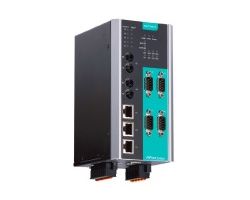Serial To Ethernet / NPort Device Servers / NPort S9450I Series
NPort S9450I Series
4-port rugged device server with managed Ethernet switch

Features and Benefits
- 4-port RS-232/422/485 serial interface
- Supports up to 5 managed Ethernet switch ports (fiber available with some models)
- DNP3 and Modbus protocols supported
- IEC 61850-3, IEEE 1613 compliant (for power substations)
- Ethernet redundancy with Turbo Ring/Chain and RSTP/STP supported
- Real COM/TTY drivers for Windows and Linux
- Supports IEC 61850 MMS protocol
- Supports IEC 62443 Level 2
- -40 to 85°C wide operating temperature
Certifications
DATASHEET DOWNLOAD GET A QUOTE
Introduction
The NPort S9450I series 4-port RS-232/422/485 device servers, which come with a built-in full-function managed Ethernet switch, are designed specifically for the harsh environmental conditions found in electrical substations. With both fiber and wire Ethernet ports supported, the combination of device server plus Ethernet switch gives users the ability to easily install, manage, and maintain the NPort S9450I itself, as well as attached serial devices.
Electromagnetic Compatibility for Harsh Substation Environments
The NPort S9000 series supports a high level of surge protection to prevent damage from the types of power surges and EMI one finds in electrical substations and industrial automation applications. Combined with a -40 to 85°C operating temperature range and galvanized steel housing, the NPort S9000 is suitable for a wide range of industrial environoments.
Another plus is the NPort S9000’s dual power supplies, which provide both redundancy, as well as a wide range of voltage inputs. The WV models accept a power 24/48 VDC power input (ranging from 18 to 72 VDC), and the HV modesl accept a power input of 88 to 300 VDC and 85 to 264 VAC.
Power SCADA with IEC 61850 MMS for Easy Maintenance
The current trend in power SCADA applications is to control and monitor both IT devices (switches, routers, etc.) and IEDs (sensors, actuators, etc.) with the MMS protocol. Contrast this with the more traditional management approach of using SNMP for IT devices and MMS for IEDs. In fact, SIs may even need to manage a variety of legacy devices that use proprietary communications protocols. The NPort S9000 device servers are the world’s first device servers to integrate MMS into an IT-type device designed specifically for power SCADA applications. The NPort S9000 even supports using MMS to monitor serial communications between the S9000 and the legacy devices.
Supports Modbus/DNP3 Protocol Gateway
The NPort S9000 series provides maximum flexibility for integrating industrial Modbus/DNP3 networks of all types and sizes. The NPort S9000 is designed to integrate Modbus TCP, ASCII, and RTU devices in almost any master/slave combination, including simultaneous serial and Ethernet masters. The NPort S9000 device servers also support protocol conversion between DNP3 serial and DNP3 IP. All models are ruggedly constructed and are DIN-rail mountable.
IEEE 62443 Level 2 Supported for Cybersecurity
The NPort S9000 series supports IEEE 62443 Level 2, and is designed for NERC CIP compliance system development to provide a high level of cybersecurity. Protecting mission-critical networks from cyber attacks is a high-priority for industrial automation applications, which can suffer large losses due to extended network downtime.
Ring Redundancy at the Device Level
Device-level communication networks for industrial automation are very critical since they are used to control and monitor device processes. The reliability of these communications depends on ring redundancy at the device level, which is designed to provide fast network fault detection and reconfiguration to support the most demanding control applications. The NPort S9000 series integrates a full-function NPort device server with an industrial switch to carry serial and Ethernet devices at the same time. In addition, the NPort S9000 can also achieve ring redundancy with standard STP/RSTP and Moxa’s proprietary Turbo Ring or Turbo Chain 2 redundancy protocols. This all-in-one design can be used to optimize and simplify your device network and enhance reliability.



